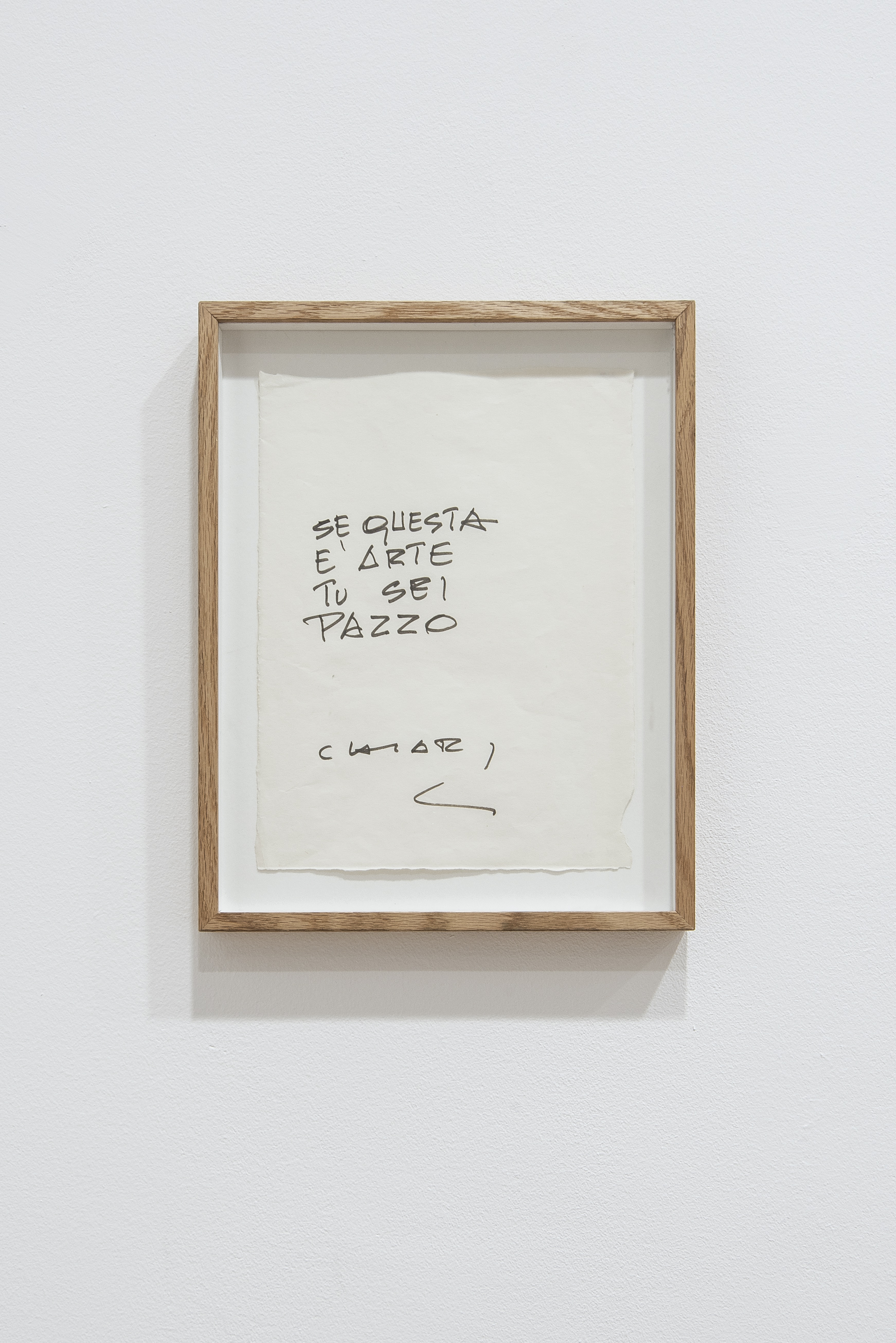








Images
![Installation view of Duetto]()
![Giuseppe Chiari, L'opera è stata alterata, 1998, marking pen on paper, cm 26,5x18]()
![Installation view Duetto]()
![Giuseppe Chiari, Diritto di visione, 1999, marking pen on paper, cm 26x19]()
![Giuseppe Chiari, Chiudere gli occhi..., 1999, marking pen on paper, cm 25x18]()
![Giuseppe Chiari, Forse tu sei centrale..., marking pen on paper, cm 33x24]()






Giuseppe Chiari
Composer and conceptual artist, born in Florence on 26 September 1926.
In Florence, alongside his university studies in mathematics and engineering (1946–51), he dedicated himself to music, studying piano and composition. Attracted most of all to the experiences of J. Cage, Chiari became interested in experimental research into visual music, and in 1961, together with P. Grossi, he promoted the association known as ‘Vita musicale contemporanea’. In the early 1960s, of great importance for Chiari’s artistic development were his meeting with S. Bussotti, his confrontation with the visual poetry research of the Gruppo 70, and lastly his contacts with the New York exponents of the international Fluxus movement, particularly from 1962 onwards, when his Gesti sul piano were performed by Frederic Rzewski at the Fluxus internationale Festspiele neuester Musik in Wiesbaden.
In addition to major group exhibitions, from Documenta 5 in Kassel (1972) to the Venice Biennale (1972; 1976; 1978) and the Biennale of Sidney (1990), Chiari developed his complex artistic path through countless concerts and performances throughout Europe and the United States.
A great advocate of the interaction between music, language, gesture and imagery, Chiari elaborated actions relating to neo-Dadaist and conceptual experiences: short pieces converge – from time to time and without a predetermined order – to form complex musical pièces, aimed at exalting the expressive freedom and the concept of indeterminacy underpinning artistic creation. Indeed, Chiari composed musica d’azione based on a complex method of performance that, alongside traditional instruments, views its essential components as random or aleatory sound elements (those of water, dry leaves or stones) that provide the cue for further elaborations, showing the constant essence of his research to lie in randomness and improvisation (Gesti su un piano, 1962; La Strada, 1965; or Suonare la città, 1965). Right from his earliest scores – in which notation or the graphic representation of the gestures to be carried out take on such visual weight as to come across as images in their own right, as pure visual elements – Chiari set about experimenting with various means of expression: from collages to pictorial-gestural solutions elaborated through signs, writings and stampings that he applied to staves, sheet music and photographs: practices which would reach their full and mature expression only in the 1980s. He died in Florence in 2007. His graphic and pictorial work is preserved in part at the Tornabuoni International Centre for Contemporary Art in Florence.
Composer and conceptual artist, born in Florence on 26 September 1926.
In Florence, alongside his university studies in mathematics and engineering (1946–51), he dedicated himself to music, studying piano and composition. Attracted most of all to the experiences of J. Cage, Chiari became interested in experimental research into visual music, and in 1961, together with P. Grossi, he promoted the association known as ‘Vita musicale contemporanea’. In the early 1960s, of great importance for Chiari’s artistic development were his meeting with S. Bussotti, his confrontation with the visual poetry research of the Gruppo 70, and lastly his contacts with the New York exponents of the international Fluxus movement, particularly from 1962 onwards, when his Gesti sul piano were performed by Frederic Rzewski at the Fluxus internationale Festspiele neuester Musik in Wiesbaden.
In addition to major group exhibitions, from Documenta 5 in Kassel (1972) to the Venice Biennale (1972; 1976; 1978) and the Biennale of Sidney (1990), Chiari developed his complex artistic path through countless concerts and performances throughout Europe and the United States.
A great advocate of the interaction between music, language, gesture and imagery, Chiari elaborated actions relating to neo-Dadaist and conceptual experiences: short pieces converge – from time to time and without a predetermined order – to form complex musical pièces, aimed at exalting the expressive freedom and the concept of indeterminacy underpinning artistic creation. Indeed, Chiari composed musica d’azione based on a complex method of performance that, alongside traditional instruments, views its essential components as random or aleatory sound elements (those of water, dry leaves or stones) that provide the cue for further elaborations, showing the constant essence of his research to lie in randomness and improvisation (Gesti su un piano, 1962; La Strada, 1965; or Suonare la città, 1965). Right from his earliest scores – in which notation or the graphic representation of the gestures to be carried out take on such visual weight as to come across as images in their own right, as pure visual elements – Chiari set about experimenting with various means of expression: from collages to pictorial-gestural solutions elaborated through signs, writings and stampings that he applied to staves, sheet music and photographs: practices which would reach their full and mature expression only in the 1980s. He died in Florence in 2007. His graphic and pictorial work is preserved in part at the Tornabuoni International Centre for Contemporary Art in Florence.


